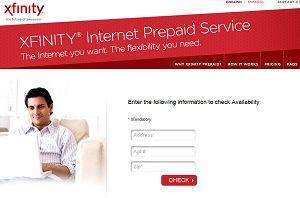Comcast Expands Prepaid Internet Trial

Comcast has quietly expanded the reach of a prepaid Internet service it’s been testing in the Philadelphia area to the vast majority of the MSO’s markets, according to research conducted last week by Multichannel News.
That research, conducted on a Comcast Web site dedicated to the prepaid offering, showed that Comcast now supports the trial service to eligible households in most of the MSO’s service areas, including Denver; Chicago; Seattle; Salt Lake City; Albuquerque; Detroit; Baltimore; Boston; Atlanta; Houston; Minneapolis; and Pittsburgh, among several others.
Although the site indicates that eligible households can currently order the prepaid product, a move that opens up the MSO to a potential new revenue source, Comcast said the offering remains in trial mode.
Comcast continues “to test this particular channel to study our operational readiness, communications and customer education to learn more,” an MSO spokesman said.
Comcast has not announced when it might launch a prepaid Internet product commercially, but the trial expansion is an indicator that Comcast is shoring up its backoffice and billing systems ahead of a national rollout.
Comcast started to test its prepaid Internet product last year in parts of Philadelphia, Delaware, and New Jersey. Comcast initially sold the service through dozens of local wireless phone stores and consumer electronics outlets, but recently shifted order fulfillment to a call-in number (855-75PREPAID), presumably to help it speed its path toward a national deployment.
The prepaid product has remained relatively unchanged since Comcast began testing it. The Starter Kit, which includes a DOCSIS 3.0 modem, the required cabling and 30 days of Internet service, costs $69.95. After 30 days, customers can refill the service for either seven days for $15, or 30 days for $45, using a credit, debit or a specialized prepaid card at xfinityprepaid.net.
Multichannel Newsletter
The smarter way to stay on top of the multichannel video marketplace. Sign up below.
Also unchanged is the maximum speed supported by the prepaid service: up to 3 Mbps downstream and 768 kbps upstream.
In an apparent decision to avoid cannibalizing its higher-margin postpaid broadband service, only homes without an active Comcast account are eligible for the prepaid product.
Comcast’s trial could serve as a blueprint for other MSOs that are mulling whether to launch similar products. The no contract, no credit check, pay-as-you-go approach opens up Comcast and other operators to markets they can’t easily pursue with a postpaid product, including former customers who have previously been switched off due to non-payment, consumers who don’t have bank accounts, or otherwise do not qualify for postpaid broadband service.
According to a report issued by the Federal Deposit Insurance Corporation (FDIC) last fall that collected responses from nearly 45,000 homes, 8.2% of all U.S. households – nearly 10 million -- were “unbanked” in 2011. More than one in four homes (28.3%) were either unbanked or underbanked, meaning they “conducted some or all of their financial transactions outside the mainstream banking system,” which includes “alternative financial services” such as payday loans, pawnshops and non-bank check cashing services.
The prepaid approach also gives Comcast a chance to chase a model that represents a significant growth engine for the cellular industry.
According to SNL Kagan senior analyst John Fletcher, U.S. cellular postpaid services achieved a 2% compound annual growth rate from 2007 to 2012, while the cellular prepaid CAGR jumped 14% during that same period. Regular postpaid cellular subs still represented 66% of the U.S. cellular market at the end of last year, versus 15% prepaid, and the reset made up of a mix that included wholesale and MVNO providers, subscriptions for tablets, health meters and other types of more non-traditional cellular connectivity services.
A prepaid service could give MSOs a new sales vector when broadband subscriber growth starts to flatten out. For now, broadband service growth remains strong. The 17 largest U.S. cable and telcos, representing 93% of the market, added 1.1 million net additional high-speed subs in the first quarter of 2013, according to Leitchtman Research Group. That total represented about 85% of the broadband add in the year-ago quarter, and about 500,000 more than the number of broadband subs added in the fourth quarter of 2012, according to LRG.
Comcast, meanwhile, added 433,000 broadband customers in the first quarter of 2013, down slightly from 439,000 added in the year-ago period. Comcast ended the quarter with a grand total of 19.79 million high-speed Internet customers.










